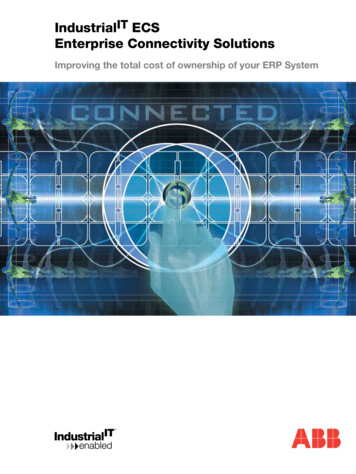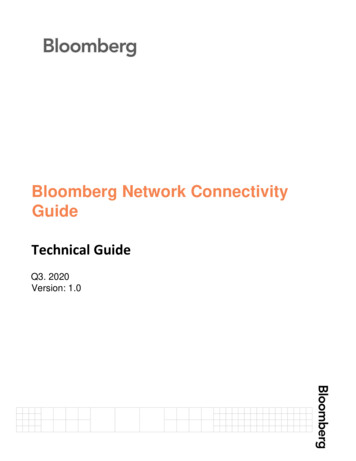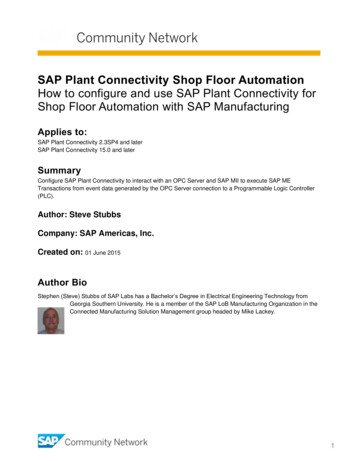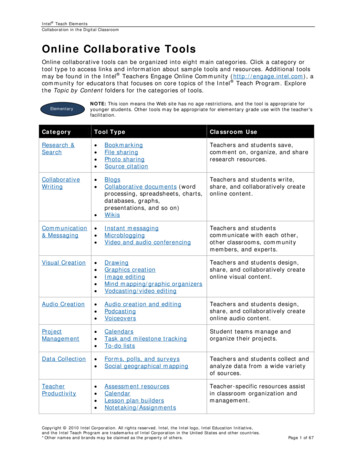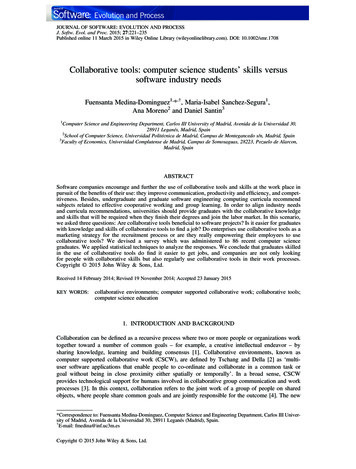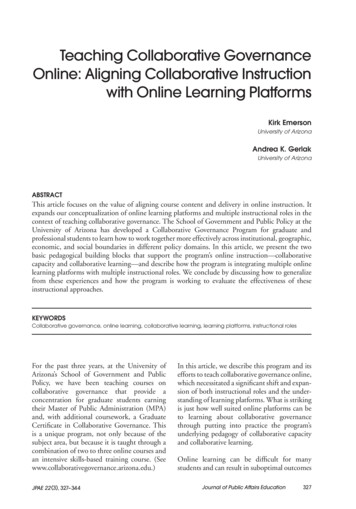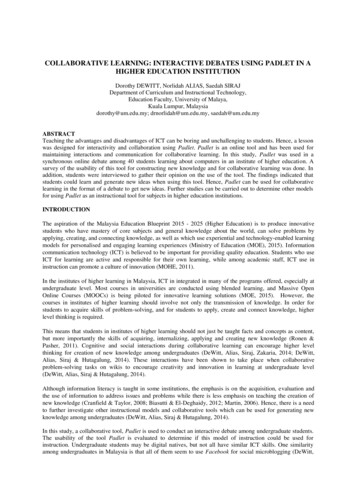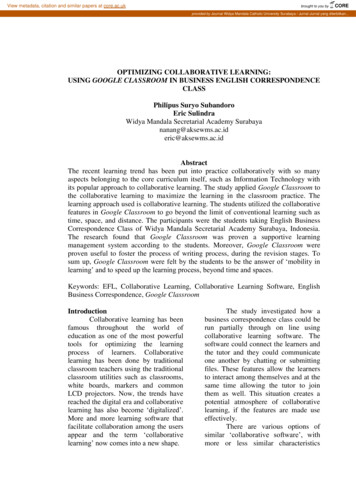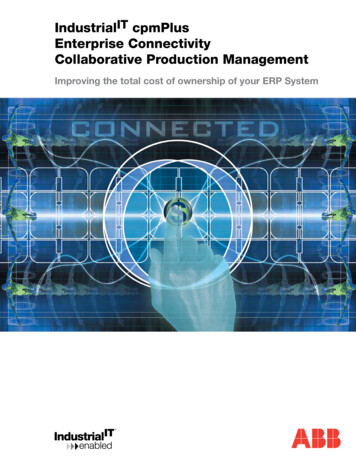
Transcription
IndustrialIT cpmPlusEnterprise ConnectivityCollaborative Production ManagementImproving the total cost of ownership of your ERP System
Realize the true value of your ERPinvestment with minimal integration effortYou’ve invested a great deal in your ERP system .in terms of time and money. While you may beeffectively managing your business systems, youmay not be using your ERP system to its fullpotential. As companies strive to become moreadaptive in the global marketplace, the integrationbetween plant operations and enterprise businessapplications brings major opportunities to improveproductivity, flexibility, quality control and to reducethe order to cash cycle. Realizing these opportunitiesultimately improves the return of your ERP systeminvestment.Even with ERP companies adopting standards likeWeb services and ISA-95, most manufacturers havemultiple systems of varying vintages. The challengebecomes obtaining the required information whilepreserving the investment in the existing systems.ABB’s Industrial IT cpmPlus EnterpriseConnectivity (ECS) bridge the vertical integrationgap between Business and Manufacturing systems,delivering significant new opportunities to increaseproductivity.figure [1] SAP View-Simple FacilitiesSAP ERP MANUFACTURINGUPLOADCONFIRMATIONDOWNLOADORDERThe connected enterprise: from thebusiness system to the plant floorAs with most major ERP suppliers, SAP hasintroduced its Web Service integration platform.Because of the complexity of ERP systems, SAPand other players have had to adopt multiple,different strategies to integrate business andmanufacturing. Where the manufacturing systemrequirements are relatively light, with productionorders being transferred from the business systemand production responses being set from theshop floor, SAP positions the xApp ManufacturingIntegration and Intelligence (xMII) as the interfaceof choice. In more complex scenarios, whereinterfacing to multiple modules inside of SAP ismore likely, SAP positions the eXchangeInfrastructure (XI) as the most suitable interface.SAP, along with other ERP vendors, has adoptedthe ISA-95 Enterprise to Manufacturing Integrationstandard for Process Industry manufacturers.While this facilitates the exchange of informationin a common format (figures 1 and 3), challengesremain. ABB addresses these challenges byenhancing the communication between SAPand manufacturing systems, as shown infigures 2 and 4.figure [2] ABB View-Simple FacilitiesSAP ERP MANUFACTURINGProduction, Quality,Maintenance, Inventory InformationSAP xMIISAP xMIIISA-95COMPLIANTMESSAGINGECSISA 95PRODUCTIONSCHEDULEISA 95PRODUCTIONPERFORMANCESHOP FLOOR AUTOMATION& CONTROL SYSTEMS[ ]Industrial IT cpmPlus Enterprise ConnectivityISA 95 Production, Quality,Maintenance, Inventory InformationSHOP FLOOR AUTOMATION& CONTROL SYSTEMS
Make the Connectionat lower cost, with fewer interfacesApart from having to deal with the significantconceptual differences between ERP andAutomation systems, perhaps one of the mostprevalent challenges is dealing with theenormous installed base that exists inmanufacturing today. These systems, few ofwhich are ISA-95 compliant, have been viewedas cost prohibitive to interface to businesssystems. ABB’s cpmPlus Enterprise Connectivityfill this gap and provides a unified frameworkfor dealing with transactional and event drivensystems in a common environment, as well asproviding a complete mapping between ISA-95messages received from xMII or XI and therequirements of the plant level systems, whetherthey are standards compatible (ISA-95, ISA-88),OPC connections, Open Database Connections(ODBC) or connecting to proprietary interfaces.Additionally, with ECS, it isn’t required that theSAP system be upgraded to NetWeaver or toimplement xMII. ECS has been designed toconnect to legacy SAP R/3 systems via moretraditional SAP interfaces such as BAPI, RFCand IDoc and to a large number of other ERPsystems through standard ECS interfaces.cpmPlus Enterprise Connectivity providea robust, easy to implement solution thatis designed to fill the gaps left by ERPinterconnect solutions.figure [3] SAP View-Complex Facilitiesfigure [4] ABB View-Complex FacilitiesSAP ERP MANUFACTURINGSAP ERP MANUFACTURINGERPSubsystemSubsystem[1][2]SHOP FLOOR AUTOMATION& CONTROL SYSTEMSSHOP FLOORERPSHOP FLOORSAP NDOWNLOADORDERSAP XIMES/CPMMES/CPMECSSHOP FLOOR AUTOMATION& CONTROL SYSTEMS[ ]ABB Inc.
Manage your businessmore effectivelyReduced Total Cost of Ownership (TCO)ECS reduces the Total Cost of Ownership (TCO) forintegration of ERP and Plant systems by using astandard product for all vertical integrations, ratherthan of custom developed Point to Point solutions.For example, a company with 20 production sitesmay need at least 50 interfaces to SAP components.SAP has stated that programming and maintenancecan cost around 20,000 per interface point; thetotal costs over a five year period are roughly 5million. With ECS, only one standard interface toSAP is required.Improved predictabilityECS enables inventory reductions by linking thereal time information about production andmaterial consumption with ERP stock and materialmanagement tools. The ECS optimizes theproduction plan by producing the right products orintermediates at the right time, in the needed quantity.cpmPlus Enterprise Connectivity also managedemand variations and increases SupplyChain flexibility through real time integrationof manufacturing units with ERP productionplanning and work order management.This business wide supervision, which providesnotification of delays, forecasted material shortage,etc., helps to prevent bottlenecks, saving you timeand money.Lower project riskECS has a standardized SAP certified interface thatuses ISA-95, SAP’s supported standard for verticalintegration in the manufacturing industries. Usingthese standard certified components dramaticallyreduces project risk. This also lowers validationefforts for regulated industries.Built in functions for failover support, messagebuffering and data validation ensure robust operation.Data is secure; if the connection is down or ERPsystem is offline for maintenance, no data will be lost.No need to rip and replace – usewhat you already haveECS works with your installed plant systems andhelps you get the most value out of the investmentsyou’ve already made. The integration capability ofthe System 800xA architecture (on which ECS isbuilt) allows the data to reside in its original system,eliminating the need to replicate it into anotherhistorian, reducing cost and improving reliability.ECS lowersDOWNLOADthe total cost of ownership by simplifying multiple connections into one standard interface.ORDERBUSINESS SOLUTIONERPCRMSCMSAP ISEINTERFACEPLANTINTERFACEABB & THIRD PARTY CONTROLSYSTEMS, HISTORIANS & CPM[ ]Industrial IT cpmPlus Enterprise Connectivity
A single point interfacefor integrationsECS provides a streamlined, single point interfacethat is suitable for enterprises of all levels ofcomplexity. Here are a few examples of how it works:In batch production, the Control Recipe is stored inthe SAP Production Planning module for ProcessIndustries. ECS downloads the control recipe andpopulates the parameters in ABB’s 800xA BatchManagement. During and after the batch execution,status updates and production information is sentto SAP from ABB’s 800xA Information Manager.This is an ideal solution for pharmaceutical,chemical and food and beverage industries.At April Indonesia, a large pulp and paper company,ECS is used for integration between SAP and ABB’sCollaborative Production Management (CPM)system in a fine paper mill. This large integrationproject has three different modules from SAP(SP, PP, PM); with up to 17,000 messagesexchanged between SAP and the ABB CPM everyday. The ABB CPM sends status updates to SAPduring production and provides a productionconfirmation once production is ready; then SAPcreates the customer invoice. SAP also getsinformation from the ABB CPM to make a Capabilityand Availability To Promise check.figure [5] ECS coverage over multiple industries.SAP ERP D SHOPFLOOR DATASAP xMII(Dashboard & KPIMonitoring)SAP XIECScpmPlus Enterprise ConnectivityCement &MineralsMetalsPulp & PaperCPM @ MetalsCPM forPaper-95Chemicals,Pharma, F&BOil & GasOffshoreOil & GasOnshore800xA BatchPIMS apps.for O&GSCADAVisionCPMKnowledgeManagerDCS800xAABB and third party control systems and historiansIn 2004 ECS was installed in ABB’s productionfacility in Dalmine, Italy. Since then, cpmPlusEnterprise Connectivity has been the standardfor connecting ABB’s manufacturing facilitieswith SAP and is being implemented in over100 factories worldwide.[ ]ABB Inc.
Standard built-in toolsmake the connection possibleThe ecsPlus Enterprise Connectivity provides the basic execution functionality and genericconnectivity needed to support configuration and servicing of connectors. It is fully scalableand includes event handling, transaction handling, error and application logging support andfailover support. It includes an array of tools to design, configure and administer the Solution:Process Definition Manager provides processdefinition, development environment, supportfor data mapping, event management anddeployment. The support for data mappingenables easy maintenance of mapping definitionsbetween the data in different applications. Eventmanagement provides real-time status monitoringof events as they are being executed.ECS Connectors are ready-to-use enterpriseservices that provide connectivity to a wide rangeof packaged applications.ECS connects to and integrates with any SAP R/3system on the BAPI, RFC or IDoc level. It usesfull SAP transactional RFC (Remote Function Call)support to enable high and simple configurabilitywhile it automatically transfers data to or from thesystem (figure 6). O PC Connector allows real-time applications todirectly connect to business systems or Portals. T CP/IP Connector provides integration withall TCP/IP based applications, such as Webservers and mail servers. X ML Connector provides processing of XMLstructures defined by a given XML schema.ERPSystemRDBMSDatabaseECSWorkflowEngine3rd PartyControls W eb Services Connector provides integrationwith enhanced SOA applications, including SAPNetWeaver (figure 7).Choice A Database Connector is a pre-built componentthat can connect with RDBMS Databases.ABB CPMfigure [6]3rd PartyHistorian800xAfigure [7]Choice BNETWEAVERSAP R/3WEB SERVICERFCIDocXIxMIIISA-95BAPIBoth options are available and ABB can usewhichever one works best in a given situation.WEB SERVICEECSECS800xA800xA[ ]Industrial IT cpmPlus Enterprise ConnectivityISA-95B2MML
Lower your ERP’s Total Cost ofOwnership with simplified system integrationABB’s cpmPlus Enterprise Connectivity are very versatile and can be used for much morethan connecting to SAP. ECS provides the capability to integrate other ERP systems, such asOracle, or SSA. It also provides integration to any Open Database Connectivity (ODBC) basedsystem, other Service Oriented Architecture (SOA) based solutions, Internet based solutionssuch as portals, eMail, instant or text messaging systems, providing a true SOA basedManufacturing Service Bus.ECS provides the mapping of objects betweenmanufacturing and business systems, usingISA-95 as the information structure. The resultingISA-95 Objects are not just part of the processworkflow definition; they couple the propertiesand aspect objects within any system or deviceconnected to the ABB System 800xA to establisha real-time connection to the correspondingobjects in the plant.ECS provides a single, highly flexible interface.Coupled with simple, straightforwardconfiguration, this results in: Lower engineering costs Lower project risk Lower interface maintenance costs Higher flexibility Higher degree of reliable information flowingbetween systemsThis helps the ERP system to better utilizemanufacturing information, allowing for fasterreactions to changing manufacturing conditions,as well as more accurate decisions made withreal-time information.To see how ABB’s System 800xA system and theCpmPlus Enterprise Connectivity option can helpyou improve the return on your ERP investment,visit us on the web at www.abb.com/cpm“It provides a comprehensive approachto enterprise integration with automationsystems. A user can take the productout of the box and configure a systemin a reasonable amount of time, withoutthe need for custom engineering andprogramming.”Larry O’Brien, ARCwire Industry News,March 3, 2006[ ]ABB Inc.
Process AutomationABB Inc.Collaborative Production Management579 Executive Campus DriveWesterville, OH 43082, USAPhone: 1 614 818 6300www.abb.com/cpmemail: info.ecs@ch.abb.comProcess AutomationABB Industry Pte Ltd.Industrial Systems DivisionNo. 2 Ayer Rajah CrescentSingapore 139935Tel: 65 6776 5711www.abb.com/cpmemail: info.ecs@ch.abb.com Copyright 2008 ABB. All rights reserved. Specifications subject to change without notice. Pictures, schematics, and other graphics contained herein are publishedfor illustration purposes only and do not represent product configurations or functionality. User documentation accompanying the product is the exclusive source forfunctionality descriptions.The IndustrialIT wordmark, Aspect Objects, and all above-mentioned names in the form XXXXXXIT are registered or pending trademarks of ABB. SAP, SAP NetWeaver,SAP R/3 and other SAP products and services mentioned herein as well as their respective logos are trademarks or registered trademarks of SAP AG in Germanyand in several other countries all over the world. All rights to other trademarks reside with their respective owners.3BUS094415 en 1336 Created by U.S. Creative ServicesProcess AutomationABB Switzerland Ltd.Collaborative Production ManagementCH-5405 Baden 5 DättwilSwitzerlandPhone: 41 (0) 58 586 84 44www.abb.com/cpmemail: info.ecs@ch.abb.com
Oracle, or SSA. It also provides integration to any Open Database Connectivity (ODBC) based system, other Service Oriented Architecture (SOA) based solutions, Internet based solutions such as portals, eMail, instant or text messaging systems, providing a true SOA based Manufacturing Service Bus.
